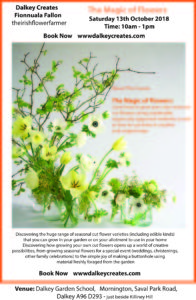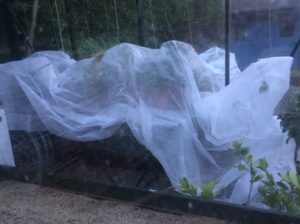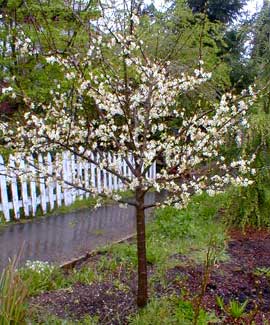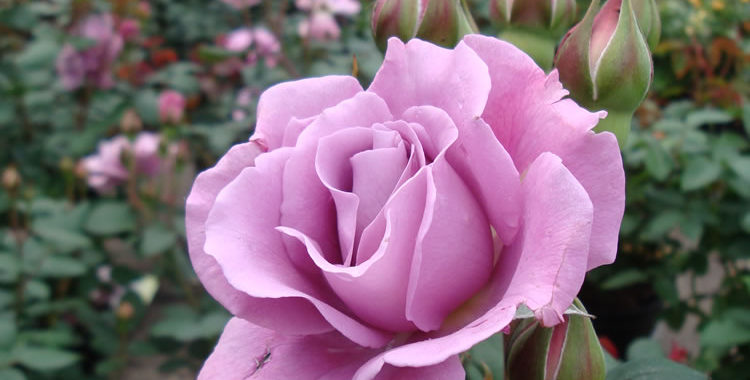Category Archives: Flowering Plants
Gardening Classes
Saturday 26 January.
GI Cooking for Weight Loss and Learn how to Plant your own Veg boxes 10 – 4 pm with Cathy Soroghan Nutrition and Fitness Training – ‘Women on the run’ and Annmarie Bowring
 Gardening opens up and awakeners an awareness to our environment, the life and beauty it holds for us.
Gardening opens up and awakeners an awareness to our environment, the life and beauty it holds for us.
Growing our own food, harvesting our own flowers, sounds of life, swish of plants, what more could we need!
A healthy vibrant gardens add so much to us, here in Dalkey Garden School we inspire you to be the best you can, to enjoy and see what is all around us.What we do, how we garden does matter.
Classes are open to alland those who want to do more. Enjoyment and sharing are key and we will be starting on with Tuesday 29 or Thursday 31st January 10 – 1pm.
Happy New Year

Wow, the weather is so mild so if you are like me still have some tidying up in the garden get out now because winter will arrive.
Remember the snow last March ? If you are not lifting your Dahlias, cover with a nice blanket of mulch as deep as you can. Canas, Gingers , Aeonium,lift or if you can add a protective cover,or take cuttings.
Still time to plant tulips and garlic( they like a good cold snap).Have a good look at your garden, look up and check on crossing branches, prune your trees, for shape and protection. Crossing branches can rub each other and cause damage to bark.
I know it is nice to have a tidy garden ,even house but in the garden leave areas for our hibernating friends.
The garden will be opening to visitors in March and our first workshop will be on Saturday 26 January, Cathy Soroghan of Women on the Run will be with me helping us cook healthy meals which will help us with our energy levels, something I am always looking for. I will be showing you how to plant and choose salads, veg for a miniature garden.Hope you can make it and again HAPPY NEW YEAR.
Annmarie
2019 Up Coming Workshops
Saturday Workshops 2019
All workshops include materials, light lunch and refreshments.
GI Cooking & Growing a container garden 10 – 4 pm 19 January
with Cathy Sorohan and Annmarie Bowring
Plant-Driven Design 10 – 4 pm 9 February
with Patrica Tyrrell
Willow weaving 10 – 1 pm 2 March
with Annmarie Bowring
Vegetable gardening and planning. 10 – 4 pm 23 March
with Klaus Laitenberger
Fabric Print with Garden Dies, 10 – 4 pm 6 April
with Freda O Dea
Easter Holidays Egg Hunting Season
Planting summer containers 10 – 1 pm 27 April
with Annmarie Bowring
Pests and Diseases 10 – 4 pm 4 May
with Ingrid Foley
Growing Herbs for Food and Nutrition 10 – 4 pm 18 May
with Joan Hanrahan & Annmarie Bowring
Summer propagation 10 – 4 pm 25 May
with Annmarie Bowring
Art in the Garden Botanical Plaster Casting 10 – 4 pm 9 June
with Dee Crofts
Art in the Garden Pen and Ink sketching 10 – 1 pm 16 June
with Mairead Byrne
Art in the Garden Plein Air Oil Painting 10 – 4 pm 23 June
with Orlagh Murphy.
Art in the garden Willow Sculptor 10-4pm 29 June
with Elaine Russell
Food Fermentation 10- 4 pm 28 September
with Gaby and Hans Weiland
DESIGNING YOUR CUT FLOWER GARDEN WITH FIONNUALA FALLON
With delight, I look forward to welcoming Fionnuala Fallon of the Irish Flower Farmer and Irish Times on Saturday 13 as part of Dalkey Creates writing festival. We will be here in Mornington Garden the home of Dalkey Garden School from 10 – 1 pm If you would like to come to call me now on 087 2256365. The cost for the morning is €45 SOLD OUT
 .
.
5 Garden Herbs for Flu Season
5 Garden Herbs for Flu Season
A very good reason to have your own selection of homegrown herbs available, the very good reason for including them in your diet, a good reason to cook from scratch. Here in Dalkey Garden School feel that understanding how to get the most from your garden, terrace, patio and balcony is really worthwhile.
Sunday, September 30.Gardening Workshop covering the basics.
The garden is now going to sleep, and now is also the time to plan your beautiful garden for next year.
Seed sowing at this time of year can give you a head start on Spring, roots develop and are stronger. Division of plants- making more, moving plants to better positions, planting bulbs for spring and summer. Feeding your soil, protecting it for the weather ahead- drought, are a few of what we will be covering.
Are Ants Bad for the Garden ?
Are ants in the garden bad?
The good and bad news about ants and plants. Just as a weed is a plant growing in the wrong place, insects in the wrong place are pests.
Ants play a very important role in the ecology of your garden for good and for not so good. …
Ants are predator and prey since they eat the eggs of many insects and serve as food for birds, lizards, and other beneficial. Their tunnels aerate the soil and allow water and nutrients to flow directly to the plant roots. They also distribute seeds by storing them in their tunnels.
The caterpillars of some butterfly groups produce a sweet substance known as honeydew to attract protectors. The ants “farm” the caterpillars, sometimes even carrying them into the ant nests to complete development. This interaction can add more butterflies and birds to your garden as they become attracted to the greater insect activity.
The bad news is that ants can protect honeydew-producing, sucking insects that do a great deal of damage, such as aphids — white, green and black fly also scale and mealybug, populations in the garden.
They actually will drag their eggs into their nests and protect them.
Wasps eat aphids. Aphids produce honeydew which ants love.
Controls of ants in your garden
Planting aromatic herbs around the perimeter of your home can also discourage ants. The added benefit is that other insects and vermin are also put off by the aroma. Any mint plant – mint needs to be planted in a container as it will become too common in your garden, also Tansy and Sage can also be effective repellents.
You can reduce their numbers by pouring boiling hot water on their nests. This technique will help you control population numbers at source.
Ants don’t like citrus. Squeeze a citrus fruit in the direction of your plant so that the juice spritzes out. This should help to repel the ants.
- To make a more heavy-duty citrus repellent, boil the rinds of half a dozen oranges in water for fifteen minutes. Also, you could use citrus drops.
- Blend the rinds and water in a food processor and pour the mixture around your plants.
- Make your own soap solution with 1 teaspoon of liquid dish soap in 1 pint of warm water or you could use washing up liquid diluted
- Spray it on and around your plant. Soaps containing peppermint oil are particularly effective.
Spices such as cinnamon, cloves, chilli powder, coffee grounds, or dried mint tea leaves can be scattered around the base of the plant to deter ants too.
Spray the flying ants ( which are mature mating creatures) with dishwashing soap
Diluted dishwashing soap is an effective agent against flying ants as it attaches to their bodies and dehydrates them.
Get yourself a spray bottle to catch the little creatures in flight and mix two generous squirts of dishwashing liquid with water. This is also effective on aphids on your plants. My mother would have used the water from the basin of washing up water to do this.
Using pesticides can damage beneficial insects and also the balance in your garden is really important to allow nature to do its job.
What to do with Fruit trees in Spring
How to look after a 5-year-old fruit tree?
What is the primary purpose of a fruit tree? Well, I suppose the hint is in the name — fruit production.
I was asked this question on Spirit Radio the other day and immediately I thought of feeding, pruning forgetting about the primary purpose of the tree — edible fruit.
- Pruning – extremely important — remove all dead, diseased wood.
- Shape tree, fruit is produced on new growth also you want to be able to harvest the fruit, so don’t it allow it to get to high and out of reach.
- Remove crossing or rubbing branches
- Check tree ties — many fruit trees especially young will need a tie with a stake for a couple of years as fruit — especially apples can be very heavy and the tree will bend with the weight. Therefore on a very young tree, it is recommended to remove most if not all of the fruit for the first year or 2.
As Mentioned the primary purpose of a fruit tree is to produce fruit.
- In autumn and overall application of well-rotted manure, could be applied around the base of the tree. Keep it back from the trunk — don’t allow it to touch as the manure is still breaking down and you don’t want to include the trunk of the tree !! You can actually buy tree guards, well worthwhile with very young trees
- In spring sprinkle a little extra feed of Potash – Potassium
- Like tomatoes — which you are also growing for their fruit, you will need a feed high in potash. necessary for flower formation — flowers lead to fruit.
- Potash is an interesting mineral.
- It has several sources,-Potassium the K in NPK nitrogen phosphate potassium
- Potassium occurs abundantly in nature. It is the 7th most common element in the earth’s crust. Certain clay minerals associated with heavy soils are rich sources of K, containing as much as 17% potash. Large potash bearing rock deposits occur in many regions of the world deriving from the minerals in ancient seas which dried up millions of years ago. Most potash for fertiliser is derived from one of these potash rocks.
- Excess potash can cause problems for plants that prefer acidic or balanced pH soils.
The woods from your fire added to your compost will have traces of the worthy ingredient. Most of the wood you burn in your firewood ash is mature or old therefore you will not have as high a concentrate as with young wood — but worth adding to your compost bin — make sure you mix it in as it can become a bit clogie — like the way grass can lump up in your compost.
Potash which literally comes from the rendering of charcoal which has been burnt down to ash at very high temperatures in a pot — hence the name potash.
Your kitchen compost — banana skins are a very good source. Adding pure mineral to your soil on occasion is ok but feeding your soil with well-mixed compost, well-rotted manure is preferable. Seaweed is another excellent source.
So to answer your question again
In spring add some extra potash (Potassium) to your soil – also good for all flowering shrubs – eg. wisteria to promote blossom.
Roses and their care
I was asked today on Spirit Radio about rose care.Not an expert on roses but I know with all flowering plants a good foundation in rich organic soil is the key to a healthy plant.
Coming into May they are should be growing well. To encourage flowers as it is all about the roses.
Pruning.
- All dead and diseased wood.
- Stand back and look at its shape.
- Branches that are crossing keep the one that will allow the plant to grow out. You should be looking for a cup shape. This allows air to circulate, cutting down on a spore bone fungus called Grey mould.
- If you didn’t get around to pruning in the autumn — this prevents the roses rocking in heavy wind and also aids shape development, prune lightly as the new growth will produce the flowers.
- Check the ground for old leaves as they can harbour the spores of last years Blackspot. Don’t add these leaves to your compost unless you know they will break down very well.
- Apply a mulch of well-rotted manure or simply an organic mulch which will prevent any remaining spores from splashing up not the new growth.
- Hopefully with a good mulch at the base protecting the soil from evaporation yours should be ok but wind can be a feature of drying — remember how our clothes dry on the clothesline, well the same applies to our plants. Keep an eye-the plant will also tell you. Roses don’t like overwatering either.
Feeding
- Some roses only flower once and the ones that repeat will need feeding during the growing season to encourage new flowers.This can be a foliar feed or a drench at the base of the plant.I will often give a second feeding just as the first big bloom starts to develop, and one more in the middle of the summer to promote later flushes.
- Also, roses need to be watered during dry spells. The Alhambra in Spain is a scented garden with many roses, and it was the development of an excellent irrigation system by the Moore’s which allowed them to do so.Repeat bloomers, you can feed them several times through the growing season to encourage additional blooms.
- Overfeeding can produce sappy growth which is open to aphid attack – back and whitefly.Using a pressurised hose to wash off is one solution Aphids, do the same job to plants that mosquitoes do to humans, they introduce a virus.
Where to grow.
- Lots of sunlight, growing in shady conditions they will not flourish to their potential.
- Traditionally rose were grown on their own — they can look magnificent but also awful.The advantage is that you are able to keep a close eye on them, preventing black spot and also easier to feed at once.Plants like companionship, as in isolation any visiting predators have only the roses to feast on.
- I like to grow mine in mixed beds, but I actually was received gifts of roses shrubs in memory of my sister Frances and ended up planting them together, but my intention is to fill up the space around them with annuals such as- Cosmos, bulbs Alliums, lavender Lavandula, Nepeta catmint, Alchemilla mollies ladies mantle, Dianthus pinks. Good companions also act as living mulches—suppressing weeds and lightly shading the soil, keeping their roots nice and cool, with their heads in the sun.
Companion planting with roses
- Good rose companions are those that hide their bare legs. Traditionally, lavender (Lavandula), catmint (Nepeta), lady’s mantle (Alchemilla)great in an arrangement, and tall growing pinks (Dianthus) Alliums all make good partners. Good companions also act as living mulches—suppressing weeds and lightly shading the soil, keeping their roots nice and cool, heads in the sun.
- Alliums including ornamental alliums deter aphids and other pests by confusing them with their strong scent. They also help roses combat black spot. While garlic and chives are most commonly recommended.That is why you will see roses growing vegetable gardens.
- Yarrow – attracts ladybugs, which will then eat any nearby aphids.
- Marigolds (Calendula and Tagetes) — deter pests and help encourage strong plant growth.
- True Geraniums – repel Japanese beetles, aphids, and other rose beetles Another important insect in your garden is the wasp as they also feed on aphids.
Planting roses.
When buying roses, to be sure you are getting the colour you want, buy them in bloom.Although the best time is in autumn, then you might not get what you want.Most roses are planted on a rootstock, that of a wild rose, leave this exposed so that if you see the growth you can prune it away — if left it will take over.
•First, give the root ball a good soak in a bucket of water for 15 minutes before you plant.If the compost is dry, it will remain dry in the hole.
•Dig a hole around one 30 cm -foot deep and at least a 30cm-foot wider all around than the root ball of the plant.
•Add some organic matter generously; again garden compost or well-rotted horse manure is ideal, around the planting hole. You want the roots to search out nutrition and not remain happy in its spot.Also, try digging a square hole.
If you are planting in a position where there had been a rose, add some Mycorrhizal Fungi to the planting hole. Make sure the roots are in contact as they act as a bridge from the roots to the soil allowing for quicker and better root establishment. Where roses had been grown previously, the soil could be tired, another good reason to add plenty of organic matter.
In Kew Botanical gardens they have completely changed the soil in their rose garden as the roses had been performing for many years and it was felt the soil was completely exhausted. Our gardens would not have had the same pressure but a healthy well-fed soil will provide great rewards, not only for roses but for all your plants.
This is the tip of the iceberg concerning roses. One more thing, plant scented roses.
I hope this was of help.
Annmarie

 namental grasses such as Stipa gigantia, Calamagrostis x acutiflora ‘Karl Foerster’ Grasses such as Stipa tenuissima – Pony Tail grass, Stipa arundinacea better to pull your fingers through and remove spent fronds.Better to wait until the soil warms up before dividing clumps of grasses and there is better new growth.
namental grasses such as Stipa gigantia, Calamagrostis x acutiflora ‘Karl Foerster’ Grasses such as Stipa tenuissima – Pony Tail grass, Stipa arundinacea better to pull your fingers through and remove spent fronds.Better to wait until the soil warms up before dividing clumps of grasses and there is better new growth. At the moment growth is very much ahead of itself, I would advise not to be complacent, remember St Patricks day last year — snow.
At the moment growth is very much ahead of itself, I would advise not to be complacent, remember St Patricks day last year — snow.


